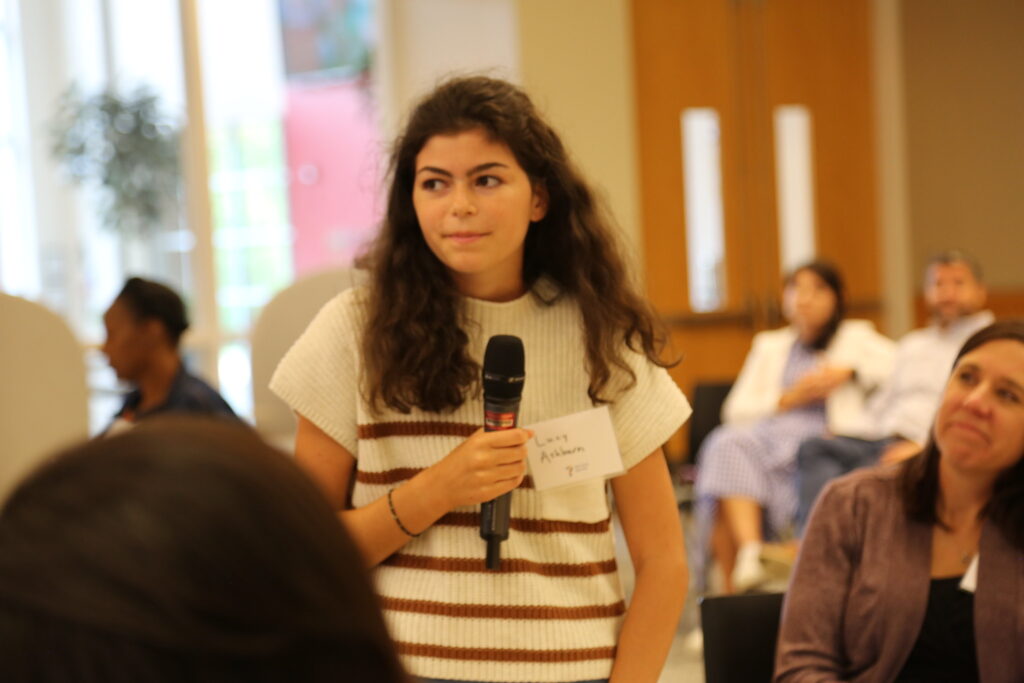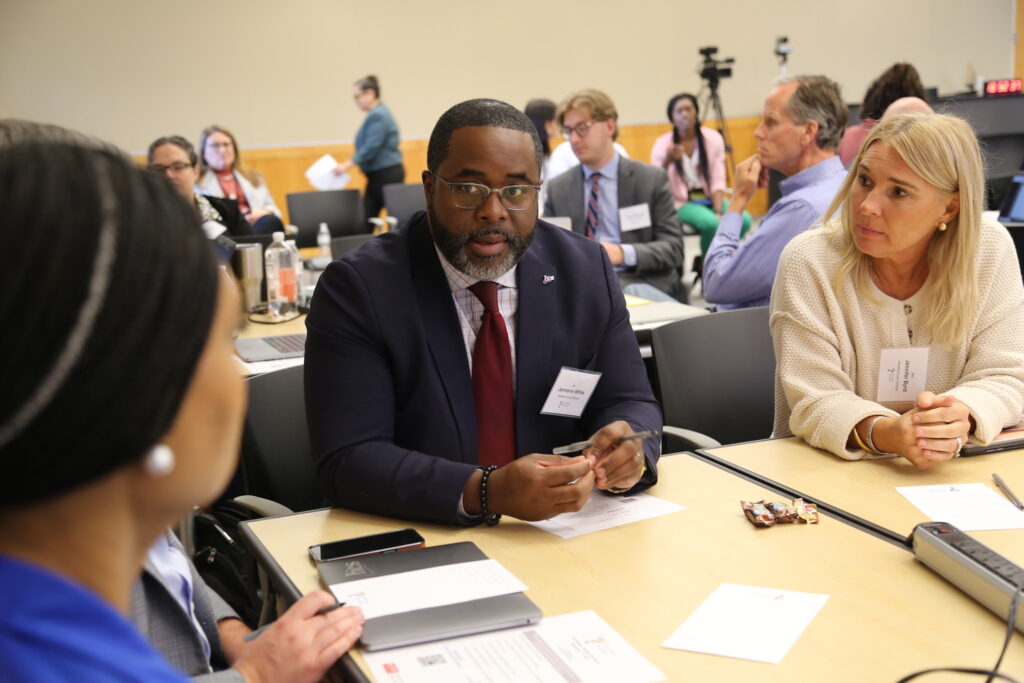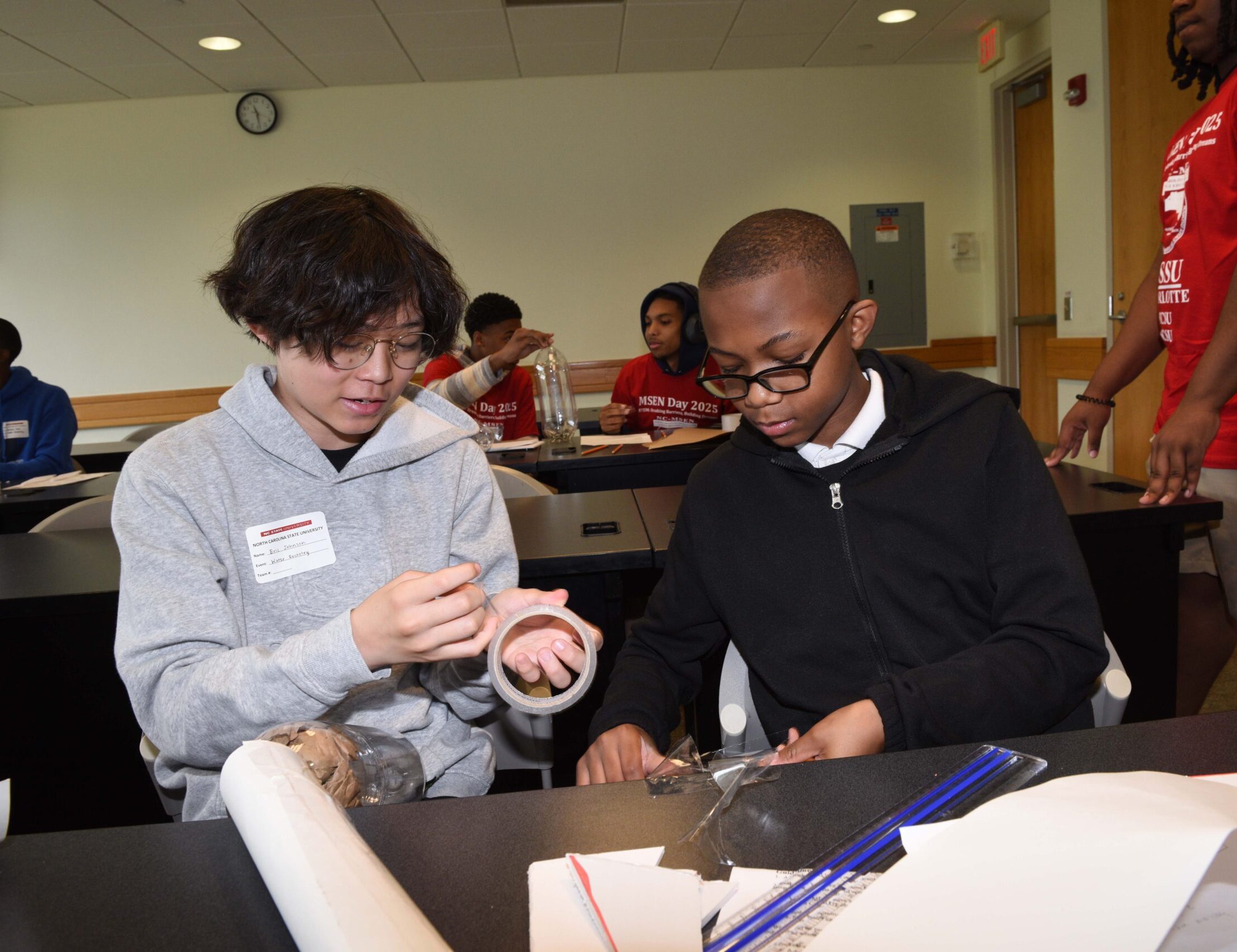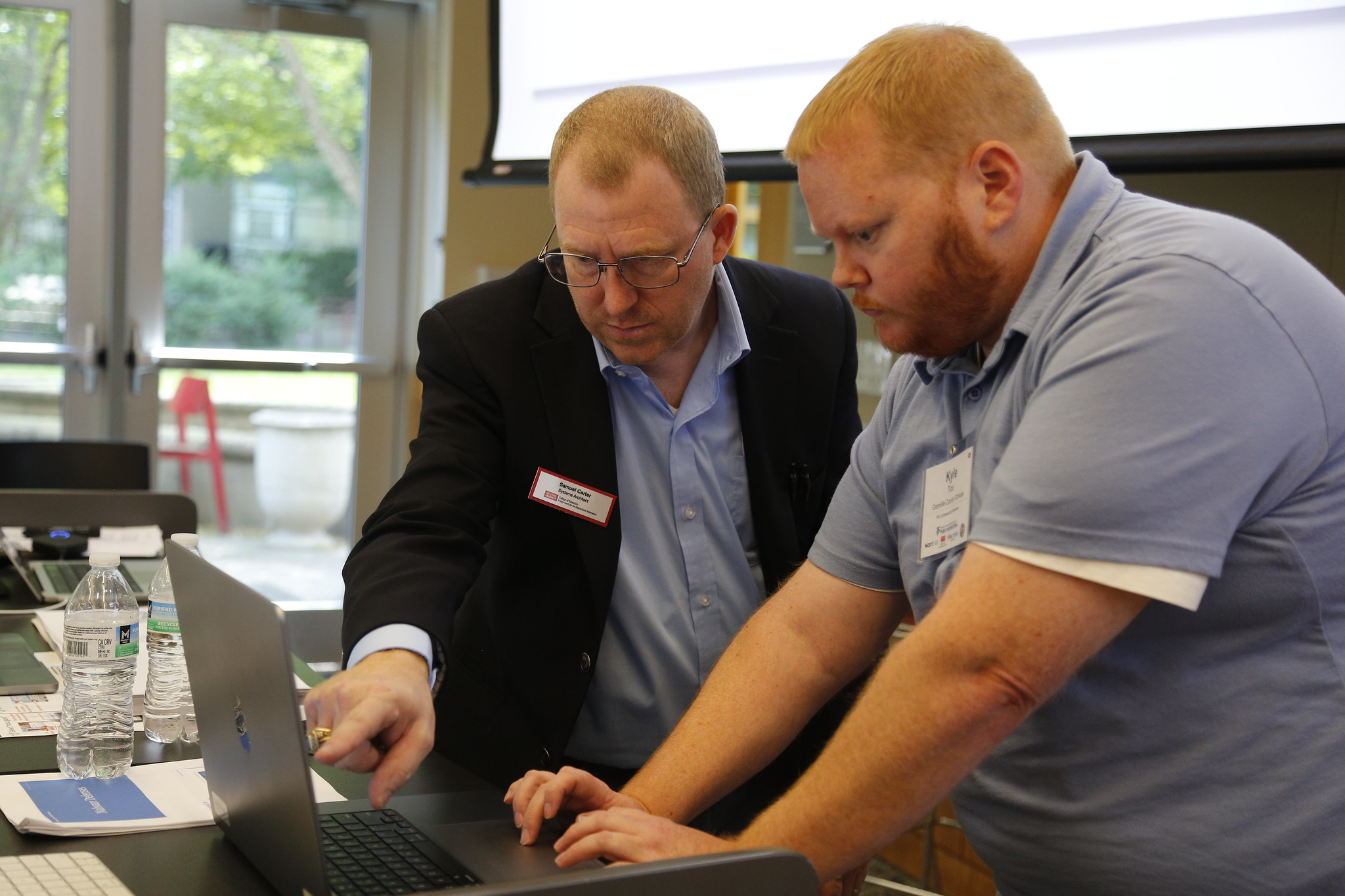Real Issues, Real Data Series Brings Together NC Education Leaders, Parents, Students, Researchers, Legislators to Discuss Cellphone Use In NC Schools

After a few weeks of implementing the Yondr pouch–a locked pouch to hold cellphones–in Chatham County Schools, a teacher told Superintendent Anthony Jackson, “I’ve been teaching in this district a long time. For the first time since the pandemic, I realized I saw my students’ eyes. I knew what the tops of their heads looked like; I saw their eyes.”
Yondr pouches are just one solution for restricting cellphone use in North Carolina schools, and the topic has been top of mind as students head back to schools and educators face another year of competing for their time and attention. Research shows that 97% of 11- to 17-year olds reported using their phones during school time and about 54% of U.S. students reported getting distracted by others using digital devices.
“I think that it’s not necessarily good to take away the phone completely, but if you have, like, some regulation, then you can have a time where the student can have a time to check their phone,” said Lucy Ashburn, an Enloe Magnet High School freshman.

“Cell Phones, Students and Schools” was the central topic of the Friday Institute for Educational Innovation’s latest Real Issues, Real Data series event on Sept. 12, which aims to elevate K-12 educators, researchers and policymakers’ understanding of contemporary educational challenges and explore pivotal topics in education.
“Our Real Issues, Real Data series features ripped-from-the-headlines topics that need further discussion and exploration through the lens of research, policy and practice,” said Emma Braaten, director of digital learning at the Friday Institute and organizer of the Real Issues, Real Data series. “At the Friday Institute, we seek to understand how these three perspectives are interconnected and have impact on the communities we serve. They also help us understand the bigger picture and the layers of complexity that may exist around these topics.”
Two of the day’s attendees included Senator Jay Chaudhuri and Senator Jim Burgin, who co-sponsored a bill in May to study cellphone use in schools. Although the bill did not pass, they are still interested in exploring this topic and pursuing legislation based on their findings.
“I think we’ve also created a phone-based childhood and even a phone-based school experience that certainly needs to be revisited, which is why I’m excited about this conference and looking at the ways that we can provide appropriate guidance to school districts on the use of cellphones,” said Chaudhuri. “And so with the return back to the school year, I think it’s critical and vital that we start having serious conversations about rethinking the use of cellphones in our school.”

The event included perspectives from students, educators, administrators and researchers, featuring sessions on youth developmental and social considerations, models and trends throughout the country, youth engagement and empowerment through cellphone access and educator reflections. The Friday Institute’s goal was to explore the impact of cellphone use on students, encouraging responsible digital habits and promoting a healthy balance through state and local guidance and policy. But at the heart of the issue are students, whose perspectives and learning were centered throughout the day.
“With the return back to the school year, I think it’s critical and vital that we start having serious conversations about rethinking the use of cellphones in our school.
-Senator Jay Chaudhuri
“Students come first in everything we do,” said Krista Glazewski, executive director of the Friday Institute and associate dean for translational research in the NC State College of Education. “We center their learning and their needs when we conduct research, support teachers or advocate for educational policy. When discussing cellphones in schools, our focus is not on the technology but on the student.”
Providing Policy, Not a Ban

A crucial perspective for this conversation included North Carolina public school educators, from those at the North Carolina Department of Public Instruction (NCDPI) to teachers, principals and superintendents across the state. Although several shared their frustrations with cellphone use in classrooms, a couple administrators emphasized that they do not want to have a complete ban on cellphones.
“This needs to not be about banning cellphones,” said North Carolina State Superintendent of Public Instruction Catherine Truitt. “It needs to be about creating policies that are right for students and their families and teachers so that our students can thrive.”
North Carolina schools do not have any formal statewide or legislative guidance related to cellphone use in schools. But, at least 22 states have proposed legislation related to cellphone use in schools and eight of those states have enacted legislation. According to Vanessa Wrenn, Chief Information Officer at NCDPI, 99% of schools have some type of cellphone policy. Although she has seen schools restrict cellphone use, Wrenn said during the event that she believes there is value to using technology in schools because of the workforce’s dependency on it.
During the “School and District Leaders’ Perspectives” panel, a few education leaders shared their paths to cell phone management in schools. Chatham County Schools implemented the Yondr Pouch Pilot Program for the 2024-2025 school year in two high schools and three middle schools The program also included several resources including a robust digital literacy program, telehealth services, a harassment reporting tool, a program to monitor Chromebook use and more. Granville County Schools Superintendent Stan Winborne talked about the importance of teacher buy-in to any implemented policy, and Topsail High School prioritized student voice and input on their policies.
“This needs to not be about banning cellphones. It needs to be about creating policies that are right for students and their families and teachers so that our students can thrive.
-North Carolina State Superintendent of Public Instruction Catherine Truitt
When advising on technology use in schools, Ji Soo Song, director of programs and initiatives at the State Educational Technology Directors Association (SETDA), believes that policies should be built to support digital health and safety.
“We do believe that any policy that aims to steer when and how technology is used in educational settings needs to be paired with intentional efforts to build students’ digital health, safety and citizenship skills, as well as efforts to build educator capacities towards this end,” said Song. “We believe that technology can serve as a vehicle that grants access to a vast network of knowledge and opportunities, but this needs to be paired with deliberate efforts to ensure that students can use these tools in a safe and responsible manner.”
What the Research Says

Research has found that cellphone usage can have both positive and negative effects on the adolescent brain while it’s in a crucial developmental stage. At the Winston National Center on Technology Use, Brain, and Psychological Development at the University of North Carolina (UNC) at Chapel Hill, co-directors Mitch Prinstein and Eva Telzer study the impact of technology and social media on the adolescent brain. During the “Youth Developmental and Social Considerations” panel, they discussed how malleable the brain is during adolescence and how cellphone use could impact its development.
“The adolescent brain is in this really important developmental phase when it is so sensitive to its social environment and the cues that it’s receiving from the environment,” said Telzer. “When those cues are potentially maladaptive, it can shape the developing brain. When those cues are potentially positive, it can really help and create a thriving adolescent.”
Prinstein agreed with Telzer, saying one way to make the experience more positive is to begin equipping students with digital literacy skills.
“We don’t give kids of age the keys to a car without teaching them the skills to protect themselves and others on the road,” said Prinstein. “We shouldn’t give kids keys to the World Wide Web without similarly teaching them those skills.”
An Equitable Access Issue
Throughout the day, there were discussions about the benefits of cellphones for adolescents, including connecting with others, staying in touch with family and friends, expressing creativity, learning how to do things and building workforce skills. But there were also concerns about their negative impacts, including hindering learning, social disconnection and distraction, sleep deprivation, exposure to inappropriate content and an increase in cyberbullying. Yet if cellphones are banned or restricted, multiple panelists discussed their negative impacts on inclusive digital practices.
“We need solutions on the structural level to make sure those families that might not be able to afford the latest iPads or broadband internet, that those kids have access to that outside of the school as well as in the school,” said Henry Willis, creator and director of the Cultural Resilience, Equity and Technology Research Lab at UMD College Park. “If they don’t have access to that, there’s this group that’s marginalized [and] is going to be left behind over time.”
“There’s not going to be one way that this is going to be addressed across every single community and district and school. How we are thinking about that is really going to matter in the context that you live and you work.
-Director of Digital Learning Emma Braaten
Throughout the day, many shared the benefits and challenges of technology and cellphones in schools. They were guided by several considerations Glazewski offered at the beginning of the day, including the transformative and powerful tools the internet and cellphones have been to reshape society and education. She argued that people can be empowered to participate more fully in society and education when technology is used properly, but when it is misused, social disconnection and distraction might occur. She also said that access to broadband internet is a concern for equitable access to education, as schools might be a student’s only access to high-speed internet to complete assignments. No matter which way policies go through, Glazewski and Braaten stressed the importance of hearing student voices and doing what was best for students when creating policies and procedures around cellphone use.
“There’s not going to be one way that this is going to be addressed across every single community and district and school,” said Braaten. “How we are thinking about that is really going to matter in the context that you live and you work. And so to me, that’s a really critical piece of what we’re talking about today is how we are coming together across the aisle to make decisions about what this looks like. We want to be on the same page that it matters for our kids…but we want to make sure that we have good pedagogical practices, we’re embedding technology in appropriate ways, we’re thinking about this strategically, and that we are also engaging our students in that conversation with their families as well.”
- Categories:


